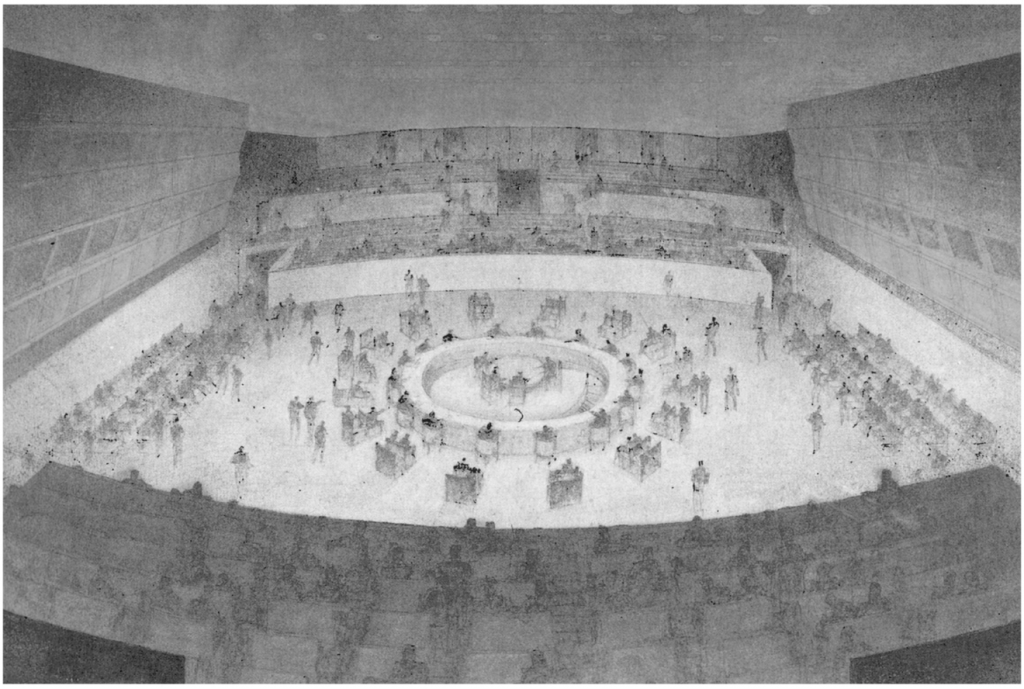UN headquarters occupy two principal buildings between First Avenue and the East River in New York, housing the General Assembly and the Secretariat respectively, as well as an additional conference building and a library. Like Westminster and Whitehall, or Strasbourg and Brussels, or any number of similar examples, they represent spatially and architecturally the distinction between its deliberative and administrative functions.
It is somehow fitting that the Secretariat should become the symbol of the UN – an upended filing case for human beings, their hopes, their fears and their aspirations for a steady job…
Our architectural genius today… lies in the design of buildings for the use of business. Our most successful structures, esthetically as well as technically, are office buildings and factories… The Secretariat is the UN to the world. By its simplicity of form and dominating mass it has become the symbol for UN. The General Assembly building does not dominate either by its physical presence or its spiritual content… The non-existent symbolism that was consciously striven for in the General Assembly got transferred subconsciously and necessarily to the real and existing symbol, the building which houses what we most believe in – paper-work, files, reports, pay-rolls, publicity…
Below the street level of the Secretariat and Conference Building, both structures where the flow of words is unimpeded, are the printing plant and recording rooms where the flow is dammed and immortalized on paper and tape. The huge plant prints everything – delegates’ speeches, reports of international portent, daily menus for the restaurant, forms.
H S Churchill, ‘United Nations Headquarters. A description and appraisal’, 1952
The UN General Assembly has a capacity of 1800, each national delegation being allocated six seats, three at a desk and three behind them, in massed ranks something like a huge theatre. The Security Council meets in a designated chamber in the conference building, around a table in ring form. The ring is broken at one side, like a horseshoe, and there are lines of observers’ chairs opposite this open side. Other chairs are lined against the side walls. A rectangular table in the centre of the ring is for stenographers and other officials.
In 1978, a consultation room was built next to the chamber, for use by Security Council members but which remains closed to representatives of other countries and to the press. Much deliberation and negotiation happens here, informally, backstage and off the record, before being presented and agreed in the open – formal, official and public – forum of the chamber.
The Green Room, a space where representatives of a select group of powerful members can express ideas outside the ken of diplomatic politesse, was reputedly so-named for the dull color of its walls… but, according to Lamy’s deputy chef de cabinet, the reference now is associated with the space offstage of theaters (rarely green in color) where performers interact informally and reflexively while awaiting the stage call.
Hadi Deeb and George Marcus, ‘In the Green Room at the WTO’, 2011
Renovation
I was told quite clearly that architecture will not force reform, and that reform will happen when it’s going to happen, on its own time. So we put it all back together again the way it was.
Michael Adlerstein, Assistant Secretary-General responsible for renovation of the UN buildings, 2014
Nancy Davenport’s Renovation includes archive and planning documents as well as her photographs of the extensive refit of the UN complex which began in 2008. One is essentially a wiring diagram of the Security Council chamber, showing the conduits which link seats to desk microphones in front of them, to each other, and to the building’s power and telecommunications networks. Lines of communication are wired into the arrangement of the room.

A drawing seems to be an architect’s original impression of the chamber, done in soft grey pencil or charcoal. The perspective is downward, from a raked auditorium seat high on one wall, into the middle of the table which is in the middle of the room. Walls to the left and right lean inward, carrying windowed interpreters’ booths overlooking the floor. The surround is heavily shaded, all the light in the picture seeming to come from the blank spaces of the floor. Grey figures sit at the table, some reaching or leaning over it, each with clusters of advisers in seats behind them. It looks like nothing so much as one of those artists’ impressions of Plato’s cave.